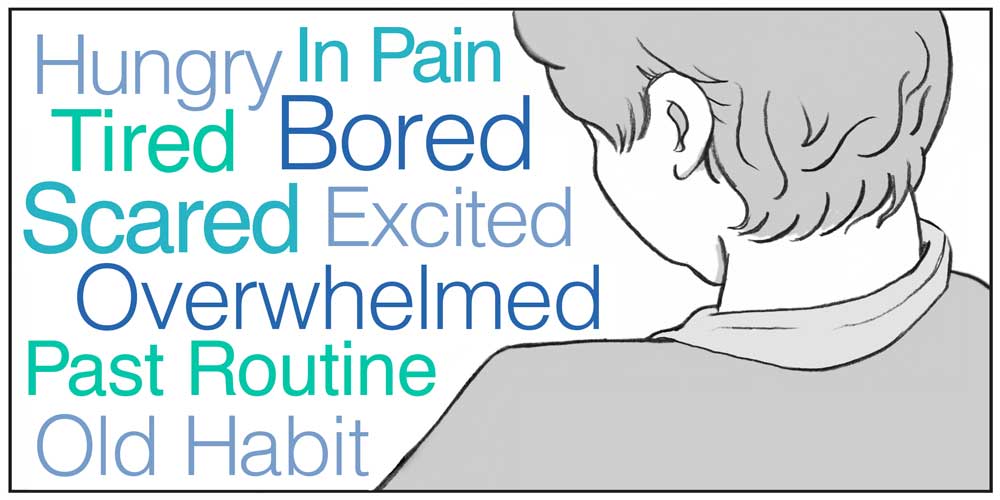Understand Behaviors
Why is this Happening?
Moments We Relate To
John started hitting care partners whenever they brushed his hair. After observing, we realized that care partners would often be kind and cheerful talking to him, but at the same time start brushing his hair while standing behind him, without telling him what they were doing. John was seated and when they stood behind him, they unknowingly scared him.
The care partners started approaching John from the front and asked John if it was okay if they brushed his hair.
This made such a big difference. John stopped hitting his care partners. A very simple solution to what could have been a huge problem.
Sound familiar? Everyone goes through similar challenges, but the way we need to approach them may be different. Let’s get started finding your just right.
Understand Behaviors
Take a moment to imagine having a very uncomfortable sore on your heel. Every afternoon, you take a walk with your wife. Every afternoon, the sore on your heel becomes worse, and then it throbs all evening. Now, imagine that you can’t think of the word heel, and you are having trouble expressing the feeling of pain to your wife. How would you feel? What might you do? Most likely, you would feel frustrated, and maybe embarrassed or inadequate. You might refuse to go on the walk or make gestures and sounds that don’t make any sense to your wife.
Written by Jennifer Brush, MA, CCC/SLP
Understanding Behaviors Handout – CLICK TO DOWNLOAD PDF | 在这里下载 | ဒီ အီၤ ဖဲအံၤတက့ၢ် | यहाँ डाउनलोड गनुर्होस्

Behaviors are a form of communication.
The word “dementia” often carries a reputation for causing negative, bad, or disruptive behaviors. Although they may seem negative to loved ones, behaviors are often just the expression or communication by the person with dementia in response to a need that is not being met.
Walk a mile in their shoes.
When we imagine ourselves in someone else’s shoes and try to view the world through his or her eyes, we are better able to interpret their behaviors. Knowing the person well can help us figure out what the person is trying to tell us.
Ask yourself: “Why is this happening?” Always remember not to assume the behavior is happening only because the person has dementia.
Begin by asking yourself “Why this behavior is happening?”
Is the person afraid? Hungry? Bored? In pain? Scared? Excited? Overwhelmed? Tired? Trying to perform an old habit? Doing a routine from the past?

The next question is addressed to the person with dementia.
“Why are you trying to leave house/empty all the milk containers/call the police, etc.?
Often this simple question sheds light on the problem and offers a solution. Of course, sometimes the person doesn’t know or cannot express why they are doing something. That’s when we need to try to be the interpreter or investigator.
For instance, if a person with dementia stops washing their hair, look at the situation surrounding showering. Was the bathroom recently remodeled with a new shower head? Maybe the person used to always shower in the morning and now you have changed their schedule and insisted that they shower at night. If we find out why the behavior is happening, we can change the environment to solve the behavior.
Often when responding to someone’s behaviors, care partners react by removing the item that is being used inappropriately or by restricting movement because of safety concerns. This is not always the best solution for someone with dementia. For example, if your loved one tries to leave the house every morning and argues with you when you ask him or her to stay in the house, your immediate reaction might be to lock all the doors. Instead, ask, “Why is my wife leaving the house? Is there something in the house that is bothering her? Would she like to work in the garden? Would she like to go for a walk? Perhaps in the past, was she in the habit of leaving for work or walking the dog right after breakfast?
If at first you don’t succeed, try again…
Next, try testing some solutions. Rather than trying to restrict her from leaving the house, try scheduling a short walk every morning right after breakfast and time in the back yard after lunch.
Here is another example.
Your husband is upsetting you because he fidgets with all of the kitchen appliances, clocks, alarm clocks, phones, mixers, etc., and he has already broken one alarm clock and a toaster. Your first instinct might be to put away all of the appliances and clocks out of sight. However, if you stop to consider why your husband might be doing this, you may come to the conclusion that he is bored. If he has always liked fixing things, maybe that is why he is behaving like this. It could be that he wants to feel useful or helpful. Try setting up a small table in the kitchen or family room with items from the thrift store that your husband can fix for you. It would be wise to set up this space close to where the care partner spends time if safety is a concern.
Of course, some problems are not so simple to solve. Instead of removing objects or restricting movements, always look for a reason for the behavior and a way to let the person engage in a meaningful activity. Most behaviors are often a response to a need to be active, safe, useful, or busy.
Don’t
X Assume the person is behaving in a certain way on purpose
X Ignore the person
X Become angry, yell, punish or scold the person
X Speck to the person as if they were a very young child
X Talk about the person while he or she is in the room
X Assume that the person is confused all of the time
X Point out everything the person cannot do
X Quiz the person about facts, details, or person’s names
Hand in Hand at Home
There are simple things you can do to transform your home into a supportive place that helps your loved one with dementia function better. We are going to show you just how to do it.
What is Dementia?
Dementia isn't a specific disease. Instead, dementia describes a group of symptoms affecting memory, thinking and social abilities severely enough to interfere with daily functioning.
Transforming Your Home
The best home environment is one that supports the abilities of the people living there.
Declutter
Understand the negative impact of clutter and take steps to improve the home environment.
Enhance Lighting
Simple changes in lighting can be made in the home to help your loved one function more independently and sleep better.
Support Memory
Create a memory center in your home to reduce confusion and foster wellbeing.
Communicate Effectively
Use a style of communication that is easier for the person with dementia to understand and follow conversations.
Understand Behaviors
Make sense of unexpected behaviors and learn how to prevent them.
Walking About
Tips for understanding and preventing walking about as well as information about how to choose a locating device.
The Power of Choice
Given them every opportunity to make informed choices about their care, leisure time, clothing, food and anything else that affects their life.
Power of Purpose
We all need a reason to get out of bed each day. People with dementia need to know their life has meaning and purpose.
Hiring Home Care
Learn how to ease the transition to additional care partners find out what questions to ask.
Self-Care
Advice for taking care of yourself, learning how and where to ask for help and scheduling breaks from caregiving.
Get Started!
You can do this! Take one step at a time. Follow these steps to get started.



